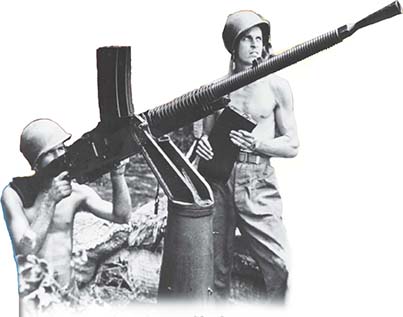SECTION 1: The Allies Turn the Tide

▲ American marines on Guadalcanal

Guadalcanal patch ►
WITNESS HISTORY  AUDIO
AUDIO
Spiders as Big as Your Fist
World War II placed U.S. soldiers in a dazzling variety of settings, from mountains to deserts to forests to tropical isles. One marine described the ordeal of fighting on a Pacific island:
“It was beautiful, but beneath the loveliness … Guadalcanal was a mass of slops and stinks and pestilence; of scum-crusted lagoons and vile swamps inhabited by giant crocodiles; a place of spiders as big as your fist and wasps as long as your finger … of ants that bite like fire, of tree leeches that fall, fasten and suck; of scorpions, of centipedes whose foul scurrying across human skin leaves a track of inflamed flesh, of snakes and land crabs, rats and bats and carrion birds and of a myriad of stinging insects.”
—Robert Leckie, Delivered From Evil: The Saga of World War II
Objectives
- Analyze the reasons for and impact of the Allies’ “Europe First” strategy.
- Explain why the battles of Stalingrad and Midway were major turning points in the war.
- Discuss how the Allies put increasing pressure on the Axis in North Africa and Europe.
Terms and People
- Dwight Eisenhower
- George S. Patton, Jr.
- unconditional surrender
- saturation bombing
- strategic bombing
- Tuskegee Airmen
- Chester Nimitz
- Battle of Midway
NoteTaking
Reading Skill: Summarize List the ways in which the Allies turned back the Axis advance.
| In Europe | In the Pacific |
|---|---|
|
|
Why It Matters The attack on Pearl Harbor brought America into World War II on the Allied side. In 1942, the Allies began to stop the seemingly unstoppable Axis onslaught. Though years of fighting lay ahead, the most aggressive threat to world peace and democracy in modern times had been halted. Section Focus Question: How did the Allies turn the tide against the Axis?
Axis and Allies Plan Strategy
By June 1942, the Allies were battered but still fighting. As you have read, British pilots had fought off a Nazi invasion of their island, while at the Battle of Coral Sea, the U.S. Navy had frustrated Japanese plans to extend their domination in the Pacific. Although the war was not close to being over, the Allies spied signs of hope.
The Axis Powers never had a coordinated strategy to defeat the Allies. Germany, Italy, and Japan shared common enemies but nurtured individual dreams. Hitler wanted to dominate Europe and eliminate “inferior” peoples. Mussolini harbored dreams of an Italian empire stretching from the eastern Adriatic to East Africa. Tojo sought Japanese control of the Western Pacific and Asia.
The Allies shared more unified goals. Roosevelt, Churchill, and Stalin considered Germany the most dangerous enemy. None felt Japan or Italy posed a serious long-term threat. Only Germany had the resources to bomb Britain, fight U.S. and British navies on the




